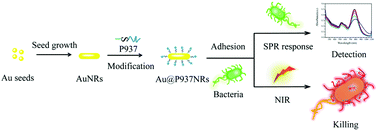Dual-functional peptide conjugated gold nanorods for the detection and photothermal ablation of pathogenic bacteria†
Abstract
It is urgent to find an effective and convenient method to detect and kill microbial strains due to the threat of pathogenic bacterial infection and the low effectiveness of antibiotics. In the present work, a dual-functional peptide coupling gold nanoconjugate (Au@P937 NRs) was facilely fabricated by conjugating an adhesion peptide (WGLHTSATNLYLHGGGC, P937) with Au nanorods (Au NRs), of which the peptide P937 was designed by the phage display biopanning technology and showed specific binding affinity to bacteria. After the modification of P937, the longitudinal surface plasmon resonance (LSPR) absorbance peak of the Au@P937 NRs was found to be very sensitive to the variation of bacterial concentration. The Au@P937 NRs exhibited enhanced NIR-based photothermal conversion efficiency. Moreover, the Au@P937 NRs exhibited good biocompatibility. Hence, the Au@P937 NRs could be used as a dual-functional nanoconjugate for the detection and photothermal ablation of bacteria. For the bacterial detection by the Au@P937 NRs, the detection limit could reach 46 cfu mL−1 for E. coli and 89 cfu mL−1 for S. aureus, respectively. Both E. coli and S. aureus could be killed completely in 10 min by the Au@P937 NRs under 808 nm laser irradiation. This work provided a facile, convenient and effective strategy for detecting and sterilizing bacteria.



 Please wait while we load your content...
Please wait while we load your content...